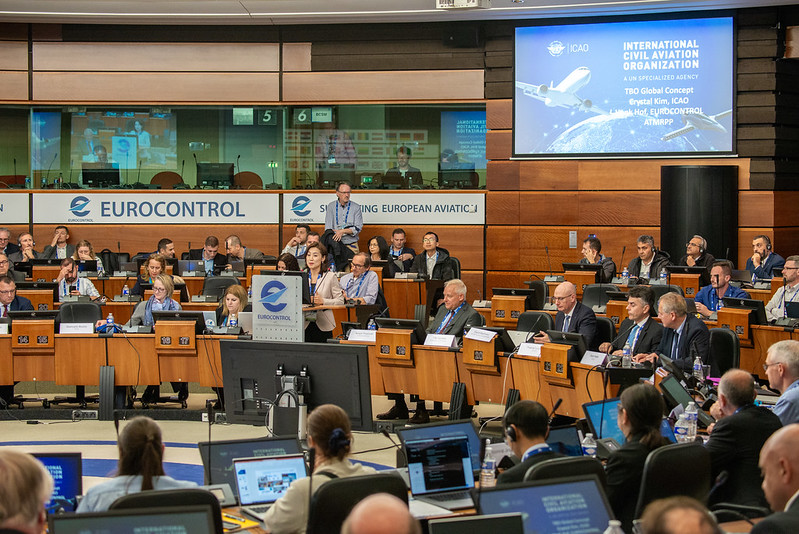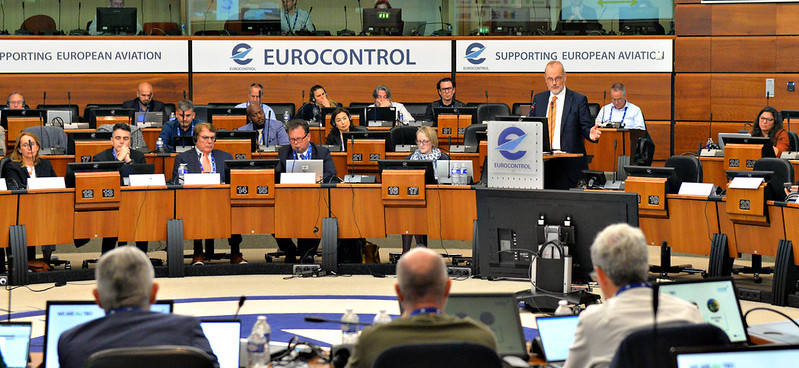Greater predictability, increased capacity and an improved environmental footprint are all on the cards for aviation as Europe and other world regions move forward with the implementation of trajectory-based operations (TBO). But the devil is in the detail, agreed stakeholders, who came together for the first-ever Global TBO Symposium in Brussels from 4 to 6 June.
Jointly organised by the European Commission, European Union Aviation Safety Agency (EASA), EUROCONTROL, SESAR Deployment Manager, and SESAR Joint Undertaking, the symposium brought together 300 participants and 3 000 viewers online representing 90 organisations from 36 countries worldwide. They discussed the enabling technologies, ongoing research, real-world applications of TBO, as well as military needs and the regulatory and standardisation efforts required for full implementation of TBO globally.

At the heart of the discussions was establishing a common understanding of what is meant by TBO. A global level ICAO-endorsed operational concept, TBO enables strategic and tactical information-sharing and collaborative decision-making across ATM. In the TBO world, flight trajectories can be tracked and managed by all the relevant ATM actors – on the ground and in the air – so that flight plans can be continuously updated before departure and even during the actual flight, and trajectories can be optimised in response to weather changes or unanticipated safety events.
Opening the symposium, Iacopo Prissinotti, Director of Network Management at EUROCONTROL, noted that there is a growing appetite for travel; traffic in Europe is back to 2019 levels with 20% less airspace and 10% more passengers. We need to accelerate our modernisation efforts to keep up with the speed of aviation growth, he said.
In his keynote address, Filip Cornelis, Director for Aviation at the European Commission, said that TBO could revolutionise aviation, just like the arrival of GNSS transformed navigation. TBO is about being “global”, “collaborative” and “sharing”, and is key to allowing aviation to grow better while reducing the environmental impact of the industry, he underlined.
Addressing the symposium, Pascal Luciani, Deputy Director of the of the Air Navigation Bureau at the International Civil Aviation Organization, said that TBO cannot be conceived as a one-nation initiative and requires continued effort over time by stakeholders to transition to TBO and deliver a seamless air navigation system for enhanced safety, capacityand sustainability.

The event was an opportunity to hear from different world regions on TBO, such as Japan, US, Canada, Singapore and Thailand. Providing a US perspective, Steve Bradford of the Federal Aviation Administration, walked participants through the evolution of TBO from foundational changes to the infrastructure to full dynamic capabilities. He noted the need to implement TBO according to specific regional needs and characteristics of the operational environment. Amornrat Jirattigalachote, AEROTHAI - Aeronautical Radio of Thailand Ltd, presented a multi-regional TBO demonstration that took place between 2021-2023 in four route segments (between US, Japan, Singapore, Thailand), ), and Wei Sean Ho, Deputy Director, Civil Aviation Authority of Singapore, who spoke about the follow-up Pathfinder project which will draw on the experience of the multi-regional demonstration. Jason Rossiter, NAV CANADA, shared lessons learned from implementation in his country, noting that TBO is not a switch that gets turned on; it will be an iterative process and needs to be planned in multiple phases. He cited notable improvements so far in efficiency and safety in Canadian airspace, adding that centralised flight planning, trajectory sharing and synchronisation will pave the way to full implementation.
In Europe, significant advances have been made in TBO in recent years. Mariagrazia La Piscopia, of the SESAR Deployment Manager said the building blocks for TBO are being put in place in Europe through synchronised deployment (Common Project 1). Cost-benefit analyses show significant gains in terms of emissions, but also in productivity and capacity. These gains will be realised once the implementation is done at scale.
In parallel, research and innovation are ongoing in SESAR projects as summarised by Olivia Nunez (SESAR JU), addressing network operations and air traffic control. The research covers pre-departure and flight planning (FF-ICE), trajectory revision (FF-ICE Release 2), airborne time constraints (ATS B2), and trajectory synchronisation, as well as the use of automation and AI to enhance trajectory predictions, support clearances and separation management, and reduce uncertainty. Peter Alty and Gérard Mavoian (EUROCONTROL), who are leading the ongoing SESAR JU projects, had the chance to share their experiences and lessons learned from the research.
The symposium concluded with a panel discussion on the European TBO roadmap and next steps, led by Andreas Boschen, Executive Director of SESAR JU, and other prominent aviation leaders. “We need a roadmap because there are so many elements that have to be implemented by so many different stakeholders. It has to be as simple as possible, comprehensive as necessary,” he said, reminding the audience about the plan in Europe to make TBO a reality progressively by 2040, as outlined in the upcoming European ATM Master Plan.
Speaking in the panel, Anna von Groote, EUROCAE, noted that there are standards already available or in the pipeline for TBO that are fit for purpose. The focus now is on establishing even closer links between SESAR deployment priorities coming out of the European ATM Master Plan campaign and the EUROCAE technical work programme. We need to leverage ICAO’s leadership to ensure global implementation, she stressed. Agreeing, Luc Tytgat, EASA, said that the next steps will be the certification of the technologies in the pipeline to confirm that they are safe and meet the expected performance requirements.
Wrapping up, Christine Berg, Deputy Director for Aviation and Head of the Single European Sky unit at the European Commission, said that frameworks like SESAR were helping to engage stakeholders both in Europe and globally to build momentum and advance ATM modernisation. She noted that roll-out takes time and so it is essential that stakeholders stay energised for the duration. She concluded that there are high expectations for a gear change to deliver the transformation that will keep aviation safe and sustainable. It’s a global challenge that requires a global answer.
Throughout the event, attendees had the opportunity to explore various exhibits showcasing advanced TBO projects and technologies from Boeing, Thales, Leonardo and the SESAR JU. These exhibits provided a hands-on look at the innovations driving the future of trajectory-based operations.

More about our TBO projects
Presentations
https://www.sesarju.eu/node/4616
Playback
DAY 1 https://www.youtube.com/live/PhoDTDQLay8?si=E_Ti83Cds8kduz8r
DAY 2 https://www.youtube.com/live/nUUcL5t8LEI?si=relb44M3hhmpPESE
https://youtu.be/bG8Y17W3sWY?si=UM285iJBBWOSRk40
DAY 3 https://www.youtube.com/live/4X0nIyAxMNY?si=-WFkYJ8IHgz-Ov98

